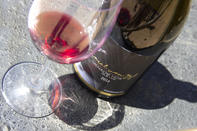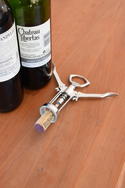Wine Industry Words
So you’re at the supermarket, scanning the shelves for the perfect bottle of wine. You see it, you select it, and you go home satisfied knowing you have a tasty alcoholic grape juice to try.

This is usually the standard process of the wine experience, with not much thought given to the wine bottle and its labels. Funny thing is, there’s actually a lot behind what’s on a wine label, and it’s more interesting than you might think.
Behind every bottle of wine is a two-part, complex label, stuffed with wine industry particulars and lingo that make little sense to the average wine drinker. Every little icon, trademark and sentence gets placed meticulously, governed by legislation set up by the Wine and Spirit Board (WSB). So before you dive into your next bottle of vino, take a closer look at the labels for an in-depth look into the world of wine regulation.
The Specifics
The labels of a wine bottle ensures that the consumer is informed about the product; it is a representation of the wine estate/wine cellar and its brand, and ensures its legitimacy. All wine labels have to be approved by the Label Committee of the Wine and Spirit Board, who are in charge of signing off on all labels before they can be used on certified wines or estate brandies.
A wine bottle will usually consist of two labels, front and back, with the latter bearing the bulk of the required information. The front label is the showcase piece of the wine estate or producer, which will have the name of the wine estate or collection name, the variety of wine, as well as the logo and/or slogan. Sometimes, the label will also consist of unique art that sets the wine apart from its competitors. Colour schemes vary, as well as font size and typography.
The back label, however, is where things get a bit more complex. As outlined by the Label Committee, certain information must appear on the label in order for it to be approved. Each word or sentence must be a specific height and width, but can vary in font and colour. Particulars include the class designation (sweet natural wine, etc.), alcohol content, the wine estate/producer’s full name and address, which can be substituted by an ‘A’ code, and finally the origin appellation.
The origin appellation becomes more prevalent when a wine is part of the Wine of Origin Scheme. These wines need to be certified by the Wine and Spirit Board according to its provisions. For example, if a wine was produced in Stellenbosch, it should be labelled ‘Wine of Origin Stellenbosch’ coupled with the name of the wine estate. To qualify for origin certification, wine producers must ensure that their origin, cultivar and vintage are in the same geographical unit.
Furthermore, health warnings are a mandatory part of the label for all wines sold in South Africa. It must make up one eighth of the label, with phrases approved by the Department of Health. An example would be: ‘Alcohol is addictive’ or ‘Alcohol reduces driving ability, don’t drink and drive’.
Certification Schemes

Other than the required front and back labels, wine bottles can have various certifications printed out on squared stickers that are added to the neck of the bottle.
The Wine and Spirit Board administers three such certification schemes, which are: Wine of Origin (WO), Estate Brandy and Integrated Production of Wine (IPW).
You would have most likely seen the IPW Integrity and Sustainability seal on a few wine bottles already.
This seal was created by Sustainable Wine South Africa (SWSA) in alliance with the Wine and Spirit Board, the Biodiversity & Wine Initiative (BWI) and Wines of South Africa (WOSA) to promote sustainable, eco-friendly production in the wine industry.
It guarantees that information relating to origin, cultivar and vintage as stated on the label are correct.
In a nutshell, wine labels are cool! They come with all sorts of requirements and considerations, but are layed out specifically with the consumer in mind - they are there to let you know that your wine is crafted with dedication and love, and should be enjoyed responsibly.